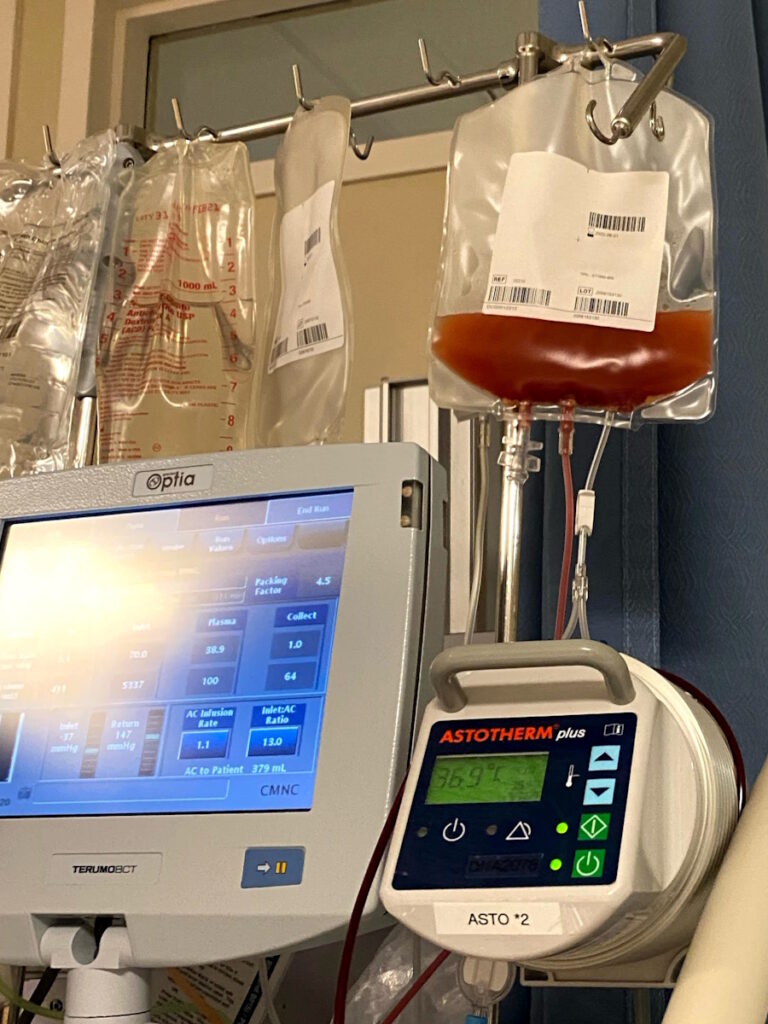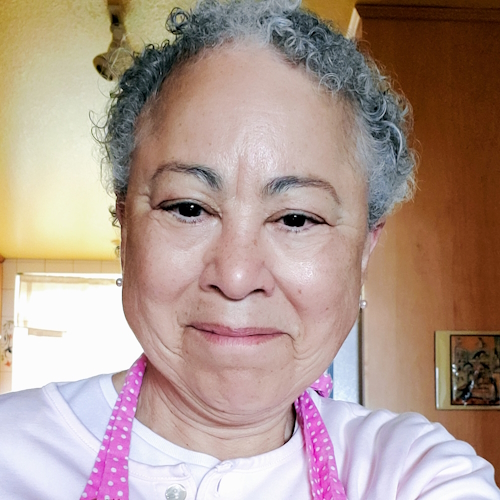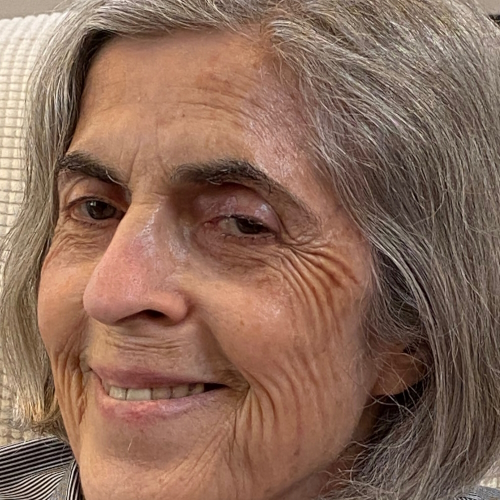From Back Pain to Cancer: Michele’s Multiple Myeloma Story
Before her diagnosis, Michele experienced fatigue, anemia, and persistent lower back pain. She attributed these symptoms to aging, overexertion, and her active lifestyle as a dancer. However, during a dance rehearsal, she felt a sharp pain in her leg that led her to the emergency room. A CT scan and X-rays revealed lesions on her spine, prompting a referral to an oncologist.
Interviewed by: Taylor Scheib
Edited by: Katrina Villareal

Michele’s primary care doctor remained persistent and ran multiple tests. Despite the normal test results, follow-up scans showed lesions on her spine, ribs, and pelvic area. She was referred to a specialist who conducted PET scans, MRIs, and other exams. Afterward, in April 2020, Michele was diagnosed with multiple myeloma. Although the cancer had been detected early, she needed immediate surgery followed by treatment.
Despite the emotional toll, Michele remained physically active. The pandemic added another layer of difficulty as she navigated treatment. She later received a stem cell transplant, a pivotal moment in her recovery. She followed the medical team’s advice, consuming ice to prevent painful mouth sores. Witnessing the stem cells entering her body gave her hope for the future.
Following Michele’s transplant, she maintained regular doctor visits and became her own health advocate. She sought support from a diverse group of people worldwide who reassured her. She was in remission for four years before she relapsed in October 2024, which deeply affected her and her family.
Michele’s current treatment includes weekly infusions and injections. She initially had to undergo eight consecutive treatment cycles and now continues with biweekly infusions, eventually transitioning to monthly treatments for 25 months. The process has been physically and emotionally draining as she grapples with feelings of anger and frustration, particularly as her independence has been impacted.
One of the most difficult aspects of Michele’s experience was missing major life events, like her youngest child’s high school graduation in 2020. The mental and spiritual toll of her illness led her to lean on her faith and support systems. Michele emphasizes the importance of surrounding herself with positivity and cutting off negative influences. Her experience taught her to advocate for herself and others, especially within her community. She remains transparent about her experience and is determined to spread awareness.
- Name: Michele J.
- Diagnosis:
- Multiple Myeloma
- Symptoms:
- Fatigue
- Anemia
- Persistent lower back pain
- Sharp leg pain during movement
- Treatments:
- Surgery
- Chemotherapy
- Stem cell transplant

During one dance rehearsal, the pain became unbearable… it got more and more intense that I had to go to the emergency room.
How I Started to Know Something Was Wrong
I didn’t know it at the time because I thought they were normal symptoms of aging and overexertion. I was experiencing fatigue, but I thought I needed to sleep more or was working out too much, and always had anemia and had bone pain in my back. When I was working, I used to have a pad to support my back. It was always the bottom of my back that would hurt a lot.
During one dance rehearsal, the pain became unbearable. We had a move where my leg had to come out and when it did, I felt a sharp, intense pain like I sprained something. I kept thinking that maybe I spread my leg out too far or something. I would do stretches, but it got more and more intense that I had to go to the emergency room, where I got a CT scan and X-rays.
When the doctor came in, he told me, “We see lesions. You may have to see an oncologist.” I immediately called my husband but he was at work an hour away, so I said, “You have to stay on the phone with me. They’re telling me that I have lesions and I have to see an oncologist.” He asked, “What’s an oncologist?” I said, “It’s cancer.” Immediately, he stopped what he did and came home. My whole life changed.

He could not understand why everything else was saying that I’m fine, but the CT scan and X-rays were saying something different.

Going to the Doctor After the Emergency Room
My primary care doctor had access to my chart, so he already saw everything. I set up an appointment with him. I was still working out and going to dance practice because I wasn’t letting that go. It’s a part of me.
He did all kinds of tests. I was due for my first colonoscopy, so I got that done. I’m very active with getting my mammograms and the test results came out fine.
My husband and I said, “Okay, it’s not in my blood, so what was this man talking about with the CT scan and X-ray?” My doctor was very persistent. He didn’t give up. He told me and my husband, “I’m going to set up an appointment with a bone doctor who specializes in cancer.”
I repeated the CT scan and X-rays. When the report came back, he could not understand why everything else was saying that I was fine, but the CT scan and X-rays were saying something different. There were lesions on my spine, rib, and pelvic area. He decided to refer me to a doctor at the University Hospital in New Orleans.
My schedule was set for Thursday after Mardi Gras. I had PET scans, an MRI, and different exams, and on April 14, 2020, he called and said, “You have multiple myeloma. It’s good news, but it’s not so good news because to tell you the truth, we can’t even stage it because we caught it early. But you do need to have surgery.” On April 22, I had my surgery and then started treatment.
I had several meltdowns and anxiety attacks, and it had a lot to do with people being mindful and careful around me.
Getting a Stem Cell Transplant
When the time came for the stem cell transplant, I was at Tulane. On the day of the transplant, they gave me something to relax. I had to eat a lot of ice because they told me that sores could develop in my mouth and throat, and I wasn’t letting that happen because I was told it was extremely painful. I enjoyed popsicles and big cups of ice, and I was able to have them during the procedure and afterwards as well.
When the stem cells arrived, they told me it would take 15 minutes for them to go through, which was amazing. I was looking at the stem cells and they were moving. That was my life. I was getting my life back. This is going to be over and I’m going to be fine.
I healed and my hair eventually grew back. Mentally, I’m still feeling better. One of the key things they told me was because I kept physically active and took care of myself, I was able to withstand the process.
No one could come to see me. I had several meltdowns and anxiety attacks, and it had a lot to do with people being mindful and careful around me.

Make sure you have somebody who understands what this is and respects the fact that you are your own advocate.

My Life After the Stem Cell Transplant
I make sure to see my doctors and have my labs done to be monitored. To try to understand what was going on with me, I became my biggest advocate. I started looking for people who looked like me, but I found a whole realm of people of all races and religious beliefs in different countries who reached out to me and let me know it was going to be okay.
Cancer Relapses
My doctor is a myeloma specialist who’s very sharp and very on point with everything, so I’m in good hands. The key is to make sure you have somebody who understands what this is and respects the fact that you are your own advocate.
He said, “Your numbers are exceptional. Let’s do a bone marrow biopsy to confirm everything.” My fourth anniversary was October 16, 2024. My doctor told me that we’re going to have to do a PET scan. The results showed that I went from 0% to 25%. I had relapsed.
This time around, I wasn’t doing well. When I told my husband that I relapsed, he looked like he was defeated. He looked like how I felt.
I have a port in my chest where I get an infusion every week. I also get a shot in my stomach. It’s humbling and scary. I’m not taking it well. I cry every day and I’m angry.
I was doing eight cycles in a row of one of the treatments. Now I’m doing every other week of one of them. Once I’m done with this part, I’ll be going once a month for 25 months.
I’m going to be as transparent as I can be, especially for people who look like me because we have to create awareness.
Emotional Part of a Cancer Diagnosis
It gets in the way of things and slows you down, which is difficult when you’re highly independent and love to get up and go like me. It wasn’t something that I was expecting. In 2020, my youngest was graduating from high school and I couldn’t go. I had to watch videos taken by his older siblings. That messes with you mentally.
When you’re going through something like this, it alters your life physically. What does it do to you mentally and spiritually? You have to find a way. You have to have your faith, and have to have your trust in God or whoever you serve or believe in. Have your affirmations, read your Bible, and open up to talk to people, especially those who are going through the same thing.
I’m always not thinking of myself but of others, and that’s another thing that I’m working on, which is working on myself. When these situations happen, they reveal a lot about people. Don’t allow negative people in your space. I can’t have them around me. I can’t force people to accept me and be my friend. I’m being your friend and trying to look out for you, but when it happens to me and you’re not there, you have to get rid of people like that.
I have no regrets. Four years of being in remission is a blessing. It allowed me to see my grandson, so I’m looking forward to all the other years to come and stay positive. It’s hard. It’s hard on my family. I’m human. I feel hurt, anger, and disappointment. I can’t be afraid of exercising because it seems like whenever I do it, the myeloma comes back, but I can’t do that.

Words of Advice
If you’re not comfortable with your doctor, don’t settle. Move on and find someone else. I became somebody who was able to help somebody. Multiple myeloma messed with the wrong person because I’m going to run and tell everybody. I’m going to be as transparent as I can be, especially for people who look like me because we have to create awareness.

Inspired by Michele's story?
Share your story, too!
More Multiple Myeloma Stories
Dr. Yvonne D., Relapsed/Refractory Multiple Myeloma
Symptoms: Severe hip pain, trouble walking due to a broken pelvis, extreme fatigue, bone pains
Treatments: Chemotherapy, stem cell transplant, radiation therapy, surgeries, CAR T-cell therapy
Michele J., Relapsed/Refractory Multiple Myeloma
Symptoms: Fatigue, anemia, persistent lower back pain, sharp leg pain during movement
Treatments: Surgery, chemotherapy, stem cell transplant
Theresa T., Relapsed/Refractory Multiple Myeloma, IgG kappa Light Chain
Symptom: Extreme pain in right hip
Treatments: Chemotherapy, CAR T-cell therapy, stem cell transplant, radiation
Laura E., Multiple Myeloma, IgG kappa
Symptom: Increasing back pain
Treatments: Chemotherapy, stem cell transplant, bispecific antibodies
Donna K., Refractory Multiple Myeloma
Symptom: None; found through blood tests
Treatments: Total Therapy Four, carfilzomib + pomalidomide, daratumumab + lenalidomide, CAR T-cell therapy, selinexor-carfilzomib





2 replies on “From Back Pain to Cancer: Michele’s Multiple Myeloma Story”
Loved Michele’s story. I find it very helpful and eye opening since I am in remission for about the same period as Michele and am waiting for the other shoe to drop! The surprising thing is I was diagnosed at stage III and have managed to stay in remission. How long will this last? Your guess is as good as mine.
I love to hear the stories, especially from people who look like me.